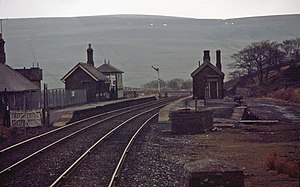Hawes Junction rail crash

Hawes Junction station, looking north. The signal box is on the down (northbound) platform
|
|
| Date | 24 December 1910 |
|---|---|
| Time | 05:49 |
| Location | Aisgill summit, Westmorland |
| Coordinates | 54°20′22″N 2°19′33″W / 54.3395°N 2.3258°WCoordinates: 54°20′22″N 2°19′33″W / 54.3395°N 2.3258°W |
| Country | England |
| Rail line | Settle-Carlisle line |
| Operator | Midland Railway |
| Cause | Signalling error |
| Statistics | |
| Trains | 2 |
| Passengers | 56 |
| Deaths | 12 |
| Injuries | 17 |
| List of UK rail accidents by year | |
The Hawes Junction rail crash occurred at 5.49 am on 24 December 1910, just north of the Lunds viaduct between Hawes Junction and Aisgill on the Midland Railway's Settle and Carlisle main line in Westmorland (now Cumbria), England. It was caused when a busy signalman, Alfred Sutton, forgot about a pair of light engines waiting at his down (northbound) starting signal to return to their shed at Carlisle. They were still waiting there when the signalman set the road for the down Scotch express. When the signal cleared, the light engines set off in front of the express into the same block section. Since the light engines were travelling at low speed from a stand at Hawes Junction, and the following express was travelling at high speed, a collision was inevitable. The express caught the light engines just after Moorcock Tunnel near Aisgill summit in Mallerstang and was almost wholly derailed.
Casualties were made worse by the telescoping (over-riding) of the timber-bodied coaches, and by fire which broke out in the coaches, fed by the gas for the coaches' lights leaking from ruptured pipes. Twelve people lost their lives as a result of this accident, some of whom were trapped in the wreckage and were burned to death.
Hawes Junction station was approximately 3.5 miles (5.6 km) miles south of Ais Gill summit, the highest point on the steeply graded Settle and Carlisle line. The Midland Railway, who owned and operated the line, had a policy of using small engines only, and many trains (both northbound and southbound) required assistance from pilot engines to climb the "big hump" to Ais Gill summit. At Ais Gill summit the pilot engines were uncoupled and ran on the up (southbound) line to Hawes Junction, where there was a turntable at the end of the "back platform road" (a loop line and platform alongside the down main line). Having been turned, light engines were usually coupled together to return to their depots (usually Leeds to the south or Carlisle to the north).
...
Wikipedia
